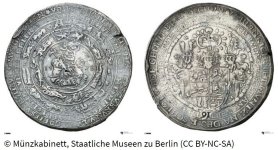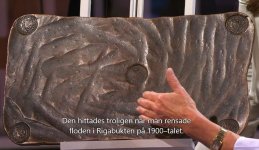Navigation
Install the app
How to install the app on iOS
Follow along with the video below to see how to install our site as a web app on your home screen.
Note: This feature may not be available in some browsers.
More options
You are using an out of date browser. It may not display this or other websites correctly.
You should upgrade or use an alternative browser.
You should upgrade or use an alternative browser.
💥👀Big silver coin 27 grms pure silver 💥
- Thread starter Jorgeke
- Start date
- Feb 3, 2009
- 41,092
- 156,806
- 🥇 Banner finds
- 1
- Detector(s) used
- Deus, Deus 2, Minelab 3030, E-Trac,
- Primary Interest:
- Relic Hunting
Did you find or wish to find?One of my favorites findings
Which is the highest diameter of a coin that officially was used??
🤔
Awesome!!! Congrats!!! Love the design of that coin!!One of my favorites findings
Which is the highest diameter of a coin that officially was used??
🤔
Last edited:
Blak bart
Gold Member
Your on fire. !!🔥🔥 I vote banner !!One of my favorites findings
Which is the highest diameter of a coin that officially was used??
🤔
I what country? Government only issues? Commemoratives? Private or territorial coins? Proof or business strikes? There are tons of options there.One of my favorites findings
Which is the highest diameter of a coin that officially was used??
🤔
Red-Coat
Gold Member
One of my favorites findings
Which is the highest diameter of a coin that officially was used??
🤔
That’s a beauty! Well done. And you raise an interesting question.
It’s complicated a bit by the existence of many modern ‘collectible’ and ‘commemorative’ coins that theoretically could circulate as legal tender but were never intended to do so (including some obscure countries in whose name coins have been struck by commercial mints). Also, there are numerous large and oddly-shaped metal items that have circulated as currency in various places which might arguably be called coins, despite not being the disc-shaped things we generally regard as such.
I don’t know for sure, but I think the leading contender for what we would recognise as a coin that definitely circulated (albeit as a bullion coin) would be the German States Principality of Brunswick-Wolfenbüttel 16 Thaler struck by Prince Julius in 1588.

The coin was struck in silver with a diameter of 72mm (2.8 inches), a thickness of 11mm (0.43 inches) and it weighed a whopping great 462g (just over 1 pound).
- Dec 30, 2012
- 8,364
- 15,798
- 🏆 Honorable Mentions:
- 2
- Detector(s) used
- Presently using Deus 2's & have Minelabs, Nokta's Tesoro's DEus's Have them all . Have WAY to many need to get rid of some
- Primary Interest:
- All Treasure Hunting
NICE FIND !! How deep ?
There were many "coins" that were not round. Japan made some "long" silver that measure 95mm+ in length.
Red-Coat
Gold Member
- Feb 9, 2020
- 7,059
- 13,506
- Detector(s) used
- XP Deus
Minelab E-Trac
- Primary Interest:
- Metal Detecting
A GREAT find - congrats !
IIRC, it was someplace like Fiji who used to use large stones as currency.....some 6+ feet in diameter.
Red-Coat
Gold Member
IIRC, it was someplace like Fiji who used to use large stones as currency.....some 6+ feet in diameter.
Yap Islands. They're known as "Rai Stones".

Rai stones - Wikipedia
Jorgeke
Bronze Member
- Oct 13, 2021
- 1,127
- 3,772
- Thread starter
- #17
Red CoatThat’s a beauty! Well done. And you raise an interesting question.
It’s complicated a bit by the existence of many modern ‘collectible’ and ‘commemorative’ coins that theoretically could circulate as legal tender but were never intended to do so (including some obscure countries in whose name coins have been struck by commercial mints). Also, there are numerous large and oddly-shaped metal items that have circulated as currency in various places which might arguably be called coins, despite not being the disc-shaped things we generally regard as such.
I don’t know for sure, but I think the leading contender for what we would recognise as a coin that definitely circulated (albeit as a bullion coin) would be the German States Principality of Brunswick-Wolfenbüttel 16 Thaler struck by Prince Julius in 1588.
View attachment 2044176
The coin was struck in silver with a diameter of 72mm (2.8 inches), a thickness of 11mm (0.43 inches) and it weighed a whopping great 462g (just over 1 pound).
Thank you very much
You provide us very interesting information, I apreciate it.
Keep in touch!
👍🏽😎
uniface
Silver Member
To pick a nit, it's not pure silver. More like .903 FWIW
Top Member Reactions
-
 3466
3466 -
 1958
1958 -
 1920
1920 -
 1164
1164 -
 1134
1134 -
 987
987 -
 867
867 -
 853
853 -
 803
803 -
 795
795 -
 745
745 -
 646
646 -
 578
578 -
 576
576 -
 486
486 -
 439
439 -
 425
425 -
E
410
-
 397
397 -
 391
391
Users who are viewing this thread
Total: 2 (members: 0, guests: 2)










